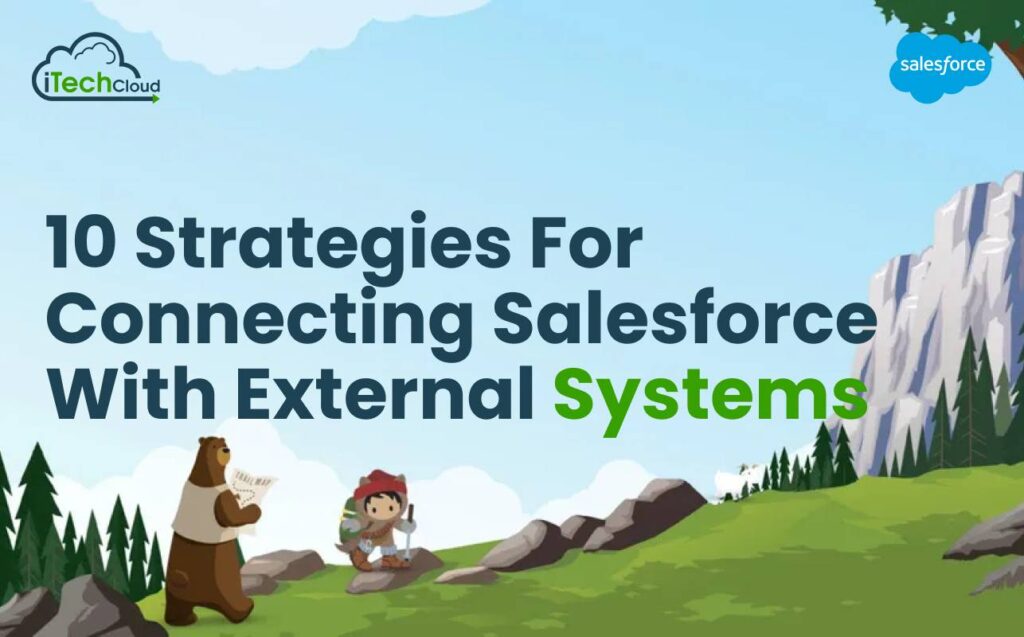10 Strategies for Connecting Salesforce with External Systems

Data integration is the backbone of efficient operations. Salesforce, a robust customer relationship management (CRM) platform, is widely used by businesses to manage customer data and drive sales. However, for organizations to harness its full potential, seamless integration with external systems is imperative. In this comprehensive guide, we will explore 10 strategic approaches, spanning both technical and organizational aspects, to seamlessly connect Salesforce with external systems.
1. Understand Your Business Needs : Connecting Salesforce
Before embarking on any integration project, it’s crucial to have a deep understanding of your business requirements. Identify the data that needs to be shared between Salesforce and external systems. This comprehensive understanding forms the foundation of a successful integration strategy.
2. Choose the Right Integration Tools
Connecting Salesforce offers a variety of integration tools and APIs (Application Programming Interfaces) designed for different integration scenarios. Choose the right tools based on your requirements. Whether it’s REST APIs for web integration, SOAP APIs for real-time communication, or bulk APIs for high-volume data processing, selecting the appropriate tools is pivotal.
3. Implement Data Governance and Security Protocols
Data security is paramount. Define strict governance policies, including data access permissions, encryption protocols, and audit trails. Ensure that sensitive information is encrypted during transmission and at rest. Often update security protocols to stay ahead of emerging threats.
4. Design a Clear Data Mapping Strategy
Establish a clear data mapping strategy between Connecting Salesforce objects and external system entities. Ensure that data fields align seamlessly, allowing for smooth data flow between systems. Proper data mapping minimizes discrepancies and ensures accurate information exchange.
5. Consider Middleware Solutions
Middleware solutions act as intermediaries between Salesforce and external systems. These platforms simplify integration by providing pre-built connectors, reducing development time and effort. Popular middleware solutions, such as MuleSoft and Dell Boom, offer extensive integration capabilities.
6. Utilize Webhooks and Platform Events
Webhooks and platform events enable real-time communication between systems. Implement these event-driven mechanisms to trigger actions in Connecting Salesforce or external systems based on specific events. Real-time data synchronization ensures that information is up-to-date across all integrated platforms.
7. Implement Robust Error Handling Mechanisms
Errors are inevitable in integration processes. Implement robust error handling mechanisms to capture errors, log them, and trigger appropriate notifications. Develop error resolution protocols to identify, rectify, and reprocess failed transactions, ensuring data integrity.
8. Monitor and Optimize Integration Performance
Continuous monitoring is essential for integration success. Implement monitoring tools to track integration performance, latency, and error rates. Analyze performance metrics to identify bottlenecks and optimize integration processes for efficiency.
9. Train and Empower Your Team
Integration success is not just about technology; it’s also about people. Invest in training programs to empower your team with the skills and knowledge required for effective integration management. A well-informed team can troubleshoot issues, optimize processes, and drive continuous improvement.
10. Establish a Scalable Architecture
Plan for scalability from the outset. As your business grows, integration demands will increase. Design a scalable architecture that can accommodate higher data volumes, additional users, and new systems. Scalable integrations ensure that your technology infrastructure grows seamlessly with your business.
Conclusion
Connecting Salesforce implementing effective strategies for connecting Salesforce with external systems is paramount for optimizing business processes and maximizing the potential of CRM. These strategies encompass leveraging robust APIs, employing middleware solutions for data orchestration, and embracing custom development for tailored integrations. Prioritizing data security, ensuring scalability, and fostering a user-friendly experience are essential considerations.
Proactive monitoring and regular updates maintain system health, while comprehensive documentation facilitates ongoing management. Collaborative partnerships with vendors and continuous evaluation of integration performance contribute to long-term success. By adopting these strategies, organizations can harness the full power of connected systems to enhance productivity, improve decision-making, and elevate customer experiences.

